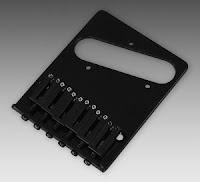Left Is The New Right

NO POLITICS HERE. Sorry to burst your bubble, this isn't a political post. This article is about Fender Telecaster style right handed and left handed bridge plates. It can apply to Fender Stratocaster style guitars too, but this article focuses on Telecaster style guitars. (Fender, Telecaster and Stratocaster are trademarks of Fender Musical Instruments Corporation) What Is The Difference? Have you ever looked closely at a Tele style bridge plate? Have you ever wondered why the bridge pickup is at an angle? Here are pictures of right handed and left handed Tele style bridge plates. Take a look at the angles of the slot for the pickup. LEFT HANDED BRIDGE PLATE RIGHT HANDED BRIDGE PLATE (The bridge plates pictures are Gotoh hardware sold by Warmoth Guitar Products) Why Angled? I have always thought the story behind the pickup angle is interesting, at least the version I've read about. The Tele bridge pickup was designed